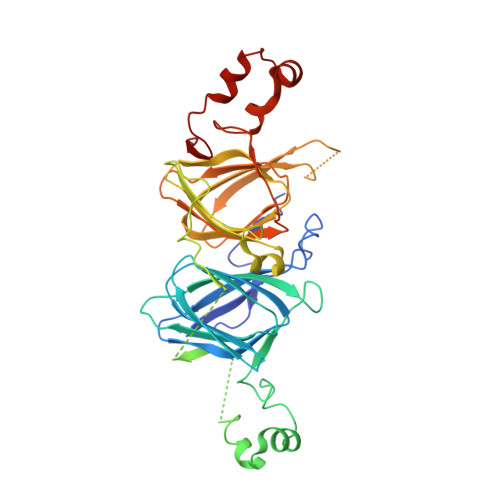Structural characterization and in-silico analysis of Momordica charantia 7S globulin for stability and ACE inhibition.
Kesari, P., Pratap, S., Dhankhar, P., Dalal, V., Mishra, M., Singh, P.K., Chauhan, H., Kumar, P.(2020) Sci Rep 10: 1160-1160
- PubMed: 31980708
- DOI: https://doi.org/10.1038/s41598-020-58138-9
- Primary Citation of Related Structures:
6KM8 - PubMed Abstract:
Momordica charantia (Mc) seeds are widely used edible crop with high nutritional quality. The food and pharmaceutical industries use it as a natural anti-oxygenic agent. Herein, a ~52 kDa protein, which is a major part of seed proteome has been purified, biochemically characterized and structure has been determined. MALDI-ESI-MS identified peptide fragments and contig-deduced sequence suggested the protein to be homologous to 7S globulins. The crystal structure shows that protein has a bicupin fold similar to 7S globulins and the electron density for a copper and acetate ligand were observed in the C-terminal barrel domain. In silico study reveals that a tripeptide (VFK) from Mc7S possess a higher binding affinity for angiotensin converting enzyme (ACE) than already reported drug Lisinopril (LPR). The protein is a glycoprotein and highly stable under varying thermal and pH conditions due to its secondary structures. The DPPH (2,2-diphenyl-1-picryl-hydrazyl-hydrate) assay showed the protein to have an anti-oxygenic nature and can aid in scavenging free radical from sample. The protein can assist to enhance the nutritional and functional value of food by acting as a food antioxidant. Further, characterization of Mc7S required which might add in importance of Mc7S as antioxidant, anti-diabetic and anti-hypertensive.
Organizational Affiliation:
Department of Biotechnology, Indian Institute of Technology Roorkee, Roorkee, Uttarakhand, 247667, India.
















